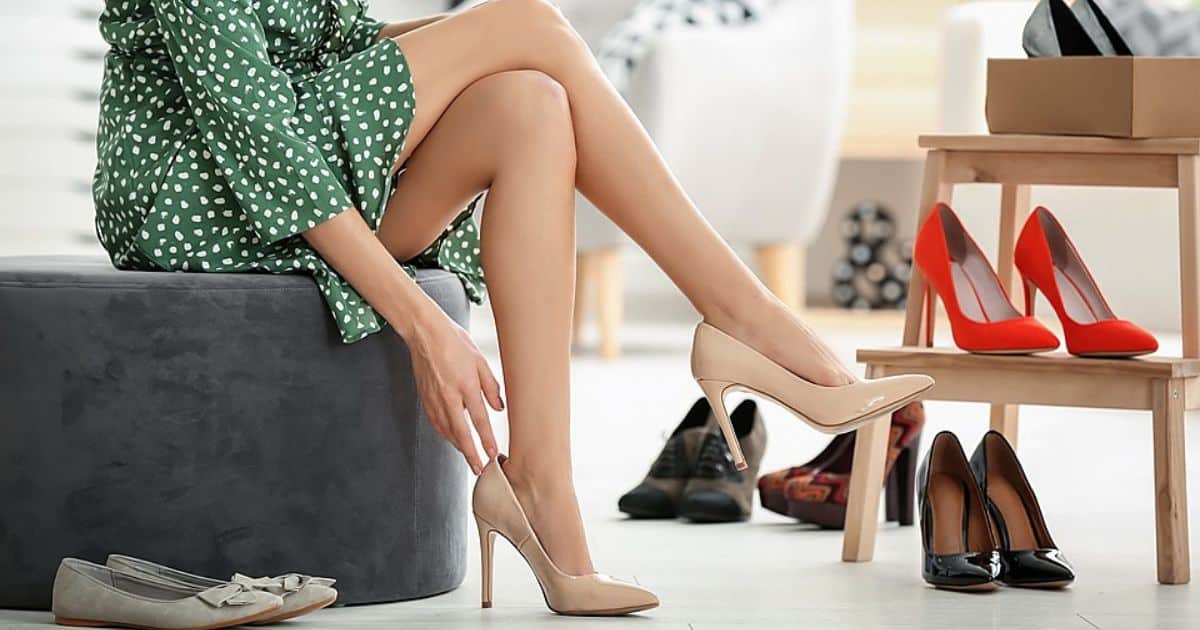Ever stumbled upon a killer deal on shoes, only to realize they’re swimming on your feet? Don’t toss ’em just yet! We’ve all been there, wrestling with footwear that’s a smidge too roomy. Whether it’s a bargain buy gone wrong or a well-intentioned gift that missed the mark, oversized shoes can be a real pain – literally. But fear not, shoe enthusiasts! We’re about to dive into the world of how to wear shoes that are too big with some life-saving footwear hacks that’ll have you strutting confidently in no time.
Why You Might End Up with Oversized Shoes
Let’s face it – ending up with shoes that are too big is more common than you’d think. Here’s why:
- Irresistible sales: Who can resist a 70% off sign? Sometimes our eyes (and wallets) are bigger than our feet. We’ve all been there, snagging a pair of dream shoes just because they’re on clearance, even if they’re not quite the right fit.
- Hand-me-downs: Aunt Mildred’s vintage loafers are to die for, but they’re not exactly a perfect fit. Family heirlooms and second-hand treasures often come with the challenge of less-than-ideal sizing.
- Weight loss: Shedding pounds can shrink your feet. Who knew? It’s true – significant weight loss can actually reduce your foot size, leaving you with shoes that suddenly feel too big.
- Growing pains: Buying shoes for kids is like shooting at a moving target. Parents often buy shoes a size up, hoping to get more wear time before the next growth spurt.
- Online shopping mishaps: With the rise of e-commerce, more people are buying shoes online without the chance to try them on first. Even with size charts, it’s easy to end up with shoes that are larger than expected.
- Brand inconsistencies: Not all shoe sizes are created equal. A size 8 in one brand might feel like a 9 in another, leading to accidental oversizing.
The Perils of Ill-Fitting Footwear
Before we jump into our life-saving hacks, let’s talk about why wearing shoes that are too big is a big no-no:
- Blisters galore: Your feet sliding around is a recipe for painful blisters. The constant friction can lead to sore spots, calluses, and even open sores.
- Tripping hazard: Oversized shoes can catch on surfaces, making you more prone to falls. This is especially dangerous on stairs or uneven terrain.
- Foot problems: Lack of proper support can lead to arch pain, plantar fasciitis, and other foot-related issues. Your feet need a snug fit to maintain proper alignment.
- Posture problems: Your whole body alignment can be thrown off by ill-fitting shoes. This can lead to knee, hip, and back pain over time.
- Reduced performance: For athletes or active individuals, oversized shoes can significantly impact performance and increase the risk of injury.
- Premature wear and tear: Shoes that are too big often wear out unevenly, shortening their lifespan and potentially causing discomfort.
Now that we’ve covered the why and the why-not, let’s dive into those 8 life-saving footwear hacks for wearing shoes that are too big.
Read This Post: Average Shoe Size for Men: How To Get Your Correct Shoe Size In America
8 Clever Hacks to Make Big Shoes Fit Better

1. Insoles: Your New Best Friend
Insoles are the unsung heroes of the footwear world. They’re not just for comfort; they can turn those clown shoes into Cinderella slippers. Here’s the lowdown:
- Types of insoles:
- Full-length: Covers the entire footbed, providing support from heel to toe.
- 3/4 length: Stops short of the toes, ideal for shoes with less space in the toe box.
- Heel cups: Focuses on the back of the foot, perfect for shoes that are just slightly too big.
- Choosing the right insole: Consider the shoe type, your foot shape, and any specific foot issues you have. Memory foam insoles are great for casual shoes, while gel insoles work wonders for heels. For athletic shoes, look for insoles with arch support and shock absorption.
- Material matters:
- Cork: Molds to your foot over time for a custom fit.
- Leather: Durable and breathable, great for dress shoes.
- Foam: Lightweight and cushiony, ideal for everyday wear.
- Pro tip: Layer thin insoles for a custom fit. Start with a supportive base and add cushioning on top. This allows you to adjust the fit as needed.
Case Study: Sarah, a busy executive, swears by layered insoles. “I have a pair of designer pumps I couldn’t bear to return. They were a half size too big, but with a supportive insole and a thin gel insert on top, they fit like a dream. I can wear them all day at the office now!”
2. Heel Grips: Nip Slippage in the Bud
Heel grips are like tiny seat belts for your heels. They stick to the back of your shoe and grip your heel, preventing that annoying slip-slide with every step.
- Materials:
- Soft suede or foam: Offers comfort and a bit of cushioning.
- Silicone: Durable and long-lasting, great for frequently worn shoes.
- Leather: Provides a luxurious feel and works well in dress shoes.
- Application:
- Clean the inside of your shoe with rubbing alcohol to ensure good adhesion.
- Peel off the adhesive backing on the heel grip.
- Carefully place the grip inside the shoe, pressing firmly to secure it.
- Let it set for 24 hours before wearing for best results.
- Pro tip: For extra staying power, use a hair dryer on low heat to warm the adhesive slightly before applying the grip.
3. Stuffing the Toe Box
This old-school trick still works wonders, especially for pointy shoes or heels.
- How-to:
- Gently stuff the toe area with cotton balls, tissue paper, or even cut-to-size insole material.
- Start with a small amount and gradually add more until you achieve the desired fit.
- Make sure the stuffing is evenly distributed to avoid lumps.
- Best for: Occasional wear or formal events where you won’t be on your feet all day.
- Materials to try:
- Cotton balls: Soft and easily moldable.
- Tissue paper: Lightweight and easy to adjust.
- Lambs wool: Natural, breathable, and conforms to your foot shape.
“I swear by the tissue paper trick for my favorite vintage heels. It’s like magic! I can wear my grandmother’s stunning 1950s pumps without them slipping off.” – Sarah, fashion blogger
4. The Double Sock Trick
Two is better than one, especially when it comes to socks in big shoes.
- How it works: Wear a thin sock underneath a thicker one to fill out extra space. This not only improves fit but also adds an extra layer of comfort.
- Best for: Athletic shoes, boots, and casual sneakers. This method is particularly effective for hiking boots or ski boots that may be rentals or hand-me-downs.
- Sock material matters:
- Inner layer: Opt for thin, moisture-wicking fabrics like silk or synthetic blends.
- Outer layer: Choose thicker socks made of wool, cotton, or cushioned synthetic materials.
- Pro tip: Experiment with different sock combinations to find the perfect fit. You might need thicker socks for winter boots and thinner pairs for summer sneakers.
5. Ball of Foot Cushions
These little wonders work by pushing your foot back in the shoe, reducing overall movement.
- Placement: Stick them just behind the ball of your foot. This helps to push your foot back into the heel of the shoe, taking up extra space.
- Types:
- Gel: Offers excellent shock absorption and comfort.
- Foam: Lightweight and ideal for everyday use.
- Fabric: Breathable and great for sensitive skin.
- Bonus: They add extra cushioning for all-day comfort, making them perfect for high heels or shoes with thin soles.
- When to use: These are especially useful for open-toed shoes or sandals where other inserts might be visible.
6. Shoe Tongue Pads
Often overlooked, tongue pads can make a world of difference, especially in lace-up shoes.
- What they do: They push your foot back and down in the shoe, improving overall fit and reducing heel slippage.
- Application:
- Clean the underside of the shoe tongue with rubbing alcohol.
- Peel off the adhesive backing on the tongue pad.
- Stick the pad to the underside of the shoe tongue, positioning it where it will rest on top of your foot.
- Best for: Dress shoes, oxfords, and sneakers. They’re particularly effective in shoes with a prominent tongue.
- Materials:
- Felt: Soft and comfortable, great for dress shoes.
- Foam: Provides extra cushioning, ideal for athletic shoes.
- Leather: Durable and breathable, perfect for long-term use.
7. Shrinking Leather Shoes
For leather shoes that are just a tad too big, try this careful shrinking method:
- Dampen the shoes with a spray bottle, focusing on the areas that need shrinking.
- Use a hairdryer on medium heat, moving constantly to avoid damage. Keep the dryer about 6 inches away from the shoe.
- Wear the shoes as they cool to mold to your feet.
- Apply a leather conditioner once dry to prevent cracking.
Caution: This method can be risky. When in doubt, consult a professional cobbler. It’s best suited for natural leather shoes and should be avoided with synthetic materials.
Expert Tip: “If you’re not comfortable trying this at home, many professional cobblers offer shoe shrinking services. It’s a small investment that can save a beloved pair of shoes.” – Mark, Master Cobbler with 30 years of experience
8. Strategic Lacing Techniques
The way you lace your shoes can significantly impact their fit. Here’s a table of lacing techniques for different fit issues:
| Issue | Lacing Technique | How It Helps |
| Heel slippage | Heel lock lacing | Creates extra friction around the ankle |
| Overall looseness | Bar lacing | Allows for tighter adjustment across the entire foot |
| High instep | Skip lacing | Relieves pressure on the top of the foot |
| Wide forefoot | Window lacing | Provides extra room in the toe box |
| Narrow feet | Zigzag lacing | Brings the sides of the shoe closer together |
Step-by-step guide for heel lock lacing:
- Lace the shoe normally until you reach the second-to-last eyelet.
- Instead of crossing over, feed each lace end up through the top eyelet on the same side.
- Create a loop on each side.
- Cross the lace ends and feed them through the opposite loop.
- Pull tight and tie as normal.
This technique creates a “lock” around your ankle, significantly reducing heel slippage in oversized shoes.
When to Give Up: Knowing the Limits of These Hacks
While these hacks can work wonders, there’s a point where you might need to throw in the towel:
- If you’re experiencing persistent pain or discomfort
- When the shoe is more than a full size too big
- If you’re compromising on safety (especially important for work boots or athletic shoes)
- When the shape of the shoe becomes visibly distorted from excessive stuffing or inserts
- If you find yourself constantly adjusting or thinking about your shoes throughout the day
Remember, your long-term foot health is more important than any shoe, no matter how stylish or discounted it might be. Wearing shoes that are significantly too large can lead to:
- Chronic foot pain
- Altered gait and posture issues
- Increased risk of falls and injuries
- Blisters and calluses
- Toenail problems
Preventive Measures: How to Avoid Buying Shoes That Are Too Big

The best hack? Avoiding the problem altogether. Here are some tips for future shoe shopping:
- Measure your feet regularly: Foot size can change over time due to age, weight fluctuations, or pregnancy. Get your feet measured at least once a year.
- Shop late in the day: Feet tend to swell as the day progresses. Trying on shoes in the afternoon or evening gives you a more accurate fit.
- Bring your own socks: Wear the type of socks you’ll typically wear with the shoes. This ensures you get the right fit for your intended use.
- Walk around: Take a stroll in the store to test the fit. Pay attention to any slipping in the heel or tightness in the toes.
- Use the thumb test: There should be about a thumb’s width of space between your longest toe and the end of the shoe.
- Consider both feet: Many people have one foot slightly larger than the other. Always fit shoes to your larger foot.
- Don’t rely on ‘breaking in’: Shoes should be comfortable from the start. While some materials may soften, the overall fit is unlikely to change dramatically.
- Shop in person when possible: While online shopping is convenient, trying on shoes in person is the best way to ensure a proper fit.
- Read reviews: When shopping online, pay attention to reviews that mention sizing. Many customers will indicate if a shoe runs large or small.
- Understand your foot type: Knowing if you have high arches, flat feet, or wide feet can help you choose shoes that fit better from the start.
Conclusion
Mastering how to wear shoes that are too big is a valuable skill in any fashion lover’s arsenal. With these 8 life-saving footwear hacks, you can rescue those oversized shoes from the back of your closet and give them a new lease on life. From insoles and heel grips to clever lacing techniques, there’s a solution for almost every oversized shoe dilemma.
Remember, the key is to experiment and find what works best for you and your unique feet. Different shoes may require different combinations of these hacks. What works for your oversized sneakers might not be the best solution for your dress shoes.
While these tricks can save many shoes, it’s important to prioritize your foot health. If a shoe is causing persistent discomfort or affecting your gait, it might be time to admit defeat and find a better-fitting pair. After all, comfortable feet are happy feet, and happy feet make for a happier you.

Maxwell Brooks, a prolific wordsmith on BlogsProto.com, navigates literary realms with grace. His prose dances through genres, captivating readers with tales that resonate, leaving an indelible mark on the digital literary landscape.











